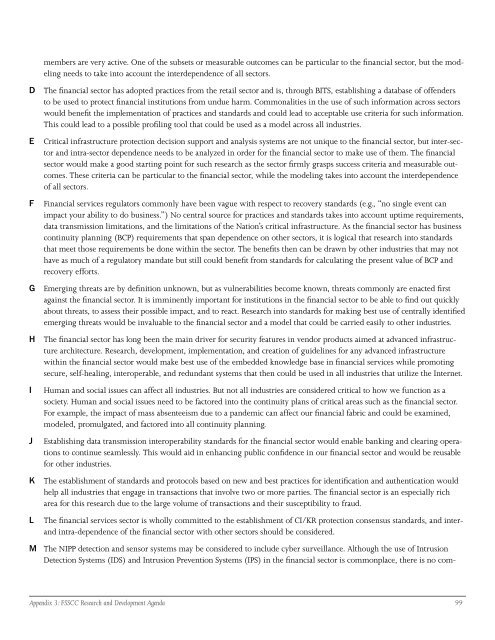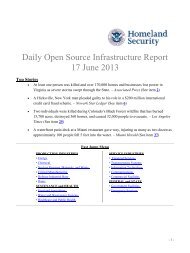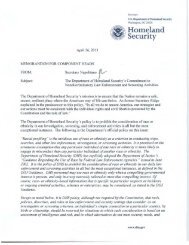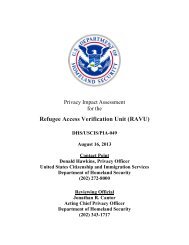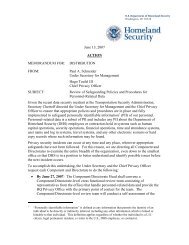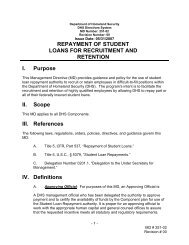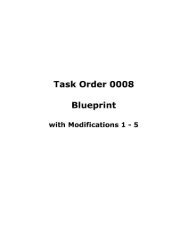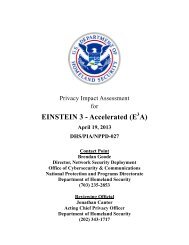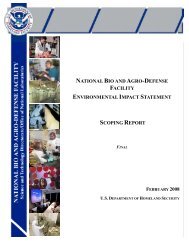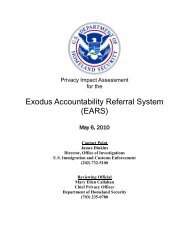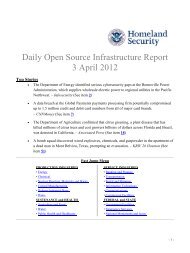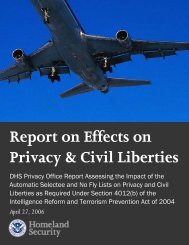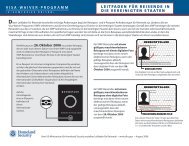Banking and Finance Sector-Specific Plan - U.S. Department of ...
Banking and Finance Sector-Specific Plan - U.S. Department of ...
Banking and Finance Sector-Specific Plan - U.S. Department of ...
You also want an ePaper? Increase the reach of your titles
YUMPU automatically turns print PDFs into web optimized ePapers that Google loves.
members are very active. One <strong>of</strong> the subsets or measurable outcomes can be particular to the financial sector, but the modeling<br />
needs to take into account the interdependence <strong>of</strong> all sectors.<br />
D The financial sector has adopted practices from the retail sector <strong>and</strong> is, through BITS, establishing a database <strong>of</strong> <strong>of</strong>fenders<br />
to be used to protect financial institutions from undue harm. Commonalities in the use <strong>of</strong> such information across sectors<br />
would benefit the implementation <strong>of</strong> practices <strong>and</strong> st<strong>and</strong>ards <strong>and</strong> could lead to acceptable use criteria for such information.<br />
This could lead to a possible pr<strong>of</strong>iling tool that could be used as a model across all industries.<br />
E Critical infrastructure protection decision support <strong>and</strong> analysis systems are not unique to the financial sector, but inter-sector<br />
<strong>and</strong> intra-sector dependence needs to be analyzed in order for the financial sector to make use <strong>of</strong> them. The financial<br />
sector would make a good starting point for such research as the sector firmly grasps success criteria <strong>and</strong> measurable outcomes.<br />
These criteria can be particular to the financial sector, while the modeling takes into account the interdependence<br />
<strong>of</strong> all sectors.<br />
F Financial services regulators commonly have been vague with respect to recovery st<strong>and</strong>ards (e.g., “no single event can<br />
impact your ability to do business.”) No central source for practices <strong>and</strong> st<strong>and</strong>ards takes into account uptime requirements,<br />
data transmission limitations, <strong>and</strong> the limitations <strong>of</strong> the Nation’s critical infrastructure. As the financial sector has business<br />
continuity planning (BCP) requirements that span dependence on other sectors, it is logical that research into st<strong>and</strong>ards<br />
that meet those requirements be done within the sector. The benefits then can be drawn by other industries that may not<br />
have as much <strong>of</strong> a regulatory m<strong>and</strong>ate but still could benefit from st<strong>and</strong>ards for calculating the present value <strong>of</strong> BCP <strong>and</strong><br />
recovery efforts.<br />
G Emerging threats are by definition unknown, but as vulnerabilities become known, threats commonly are enacted first<br />
against the financial sector. It is imminently important for institutions in the financial sector to be able to find out quickly<br />
about threats, to assess their possible impact, <strong>and</strong> to react. Research into st<strong>and</strong>ards for making best use <strong>of</strong> centrally identified<br />
emerging threats would be invaluable to the financial sector <strong>and</strong> a model that could be carried easily to other industries.<br />
H The financial sector has long been the main driver for security features in vendor products aimed at advanced infrastructure<br />
architecture. Research, development, implementation, <strong>and</strong> creation <strong>of</strong> guidelines for any advanced infrastructure<br />
within the financial sector would make best use <strong>of</strong> the embedded knowledge base in financial services while promoting<br />
secure, self-healing, interoperable, <strong>and</strong> redundant systems that then could be used in all industries that utilize the Internet.<br />
I Human <strong>and</strong> social issues can affect all industries. But not all industries are considered critical to how we function as a<br />
society. Human <strong>and</strong> social issues need to be factored into the continuity plans <strong>of</strong> critical areas such as the financial sector.<br />
For example, the impact <strong>of</strong> mass absenteeism due to a p<strong>and</strong>emic can affect our financial fabric <strong>and</strong> could be examined,<br />
modeled, promulgated, <strong>and</strong> factored into all continuity planning.<br />
J Establishing data transmission interoperability st<strong>and</strong>ards for the financial sector would enable banking <strong>and</strong> clearing operations<br />
to continue seamlessly. This would aid in enhancing public confidence in our financial sector <strong>and</strong> would be reusable<br />
for other industries.<br />
K The establishment <strong>of</strong> st<strong>and</strong>ards <strong>and</strong> protocols based on new <strong>and</strong> best practices for identification <strong>and</strong> authentication would<br />
help all industries that engage in transactions that involve two or more parties. The financial sector is an especially rich<br />
area for this research due to the large volume <strong>of</strong> transactions <strong>and</strong> their susceptibility to fraud.<br />
L The financial services sector is wholly committed to the establishment <strong>of</strong> CI/KR protection consensus st<strong>and</strong>ards, <strong>and</strong> inter<strong>and</strong><br />
intra-dependence <strong>of</strong> the financial sector with other sectors should be considered.<br />
M The NIPP detection <strong>and</strong> sensor systems may be considered to include cyber surveillance. Although the use <strong>of</strong> Intrusion<br />
Detection Systems (IDS) <strong>and</strong> Intrusion Prevention Systems (IPS) in the financial sector is commonplace, there is no com-<br />
Appendix : FSSCC Research <strong>and</strong> Development Agenda


